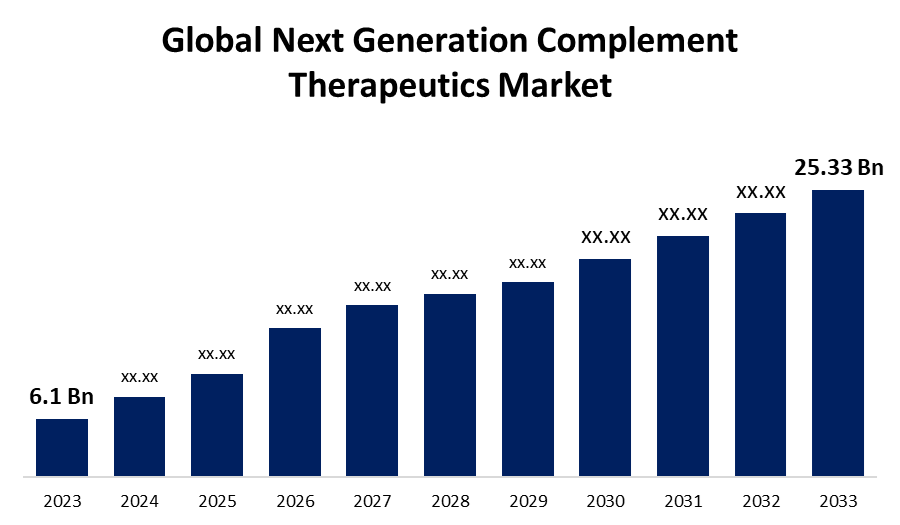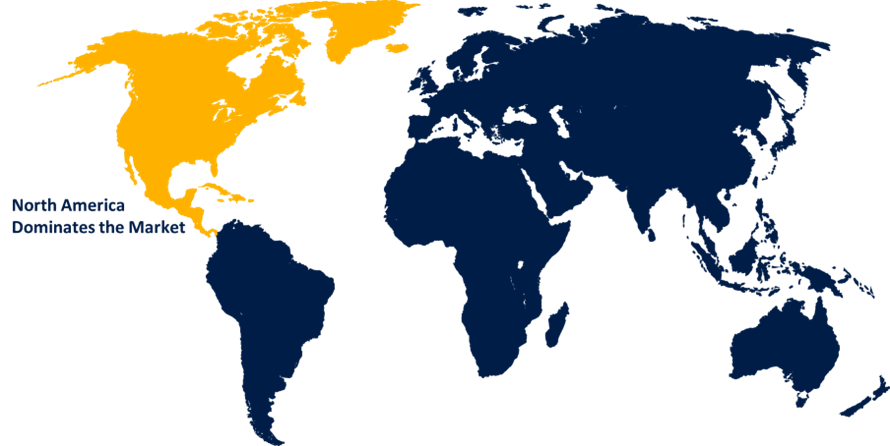Global Next Generation Complement Therapeutics Market Size, Share, and COVID-19 Impact Analysis, By Molecule Type (Biologic, Small Molecule), By Therapeutic Area (Cardiovascular, Genetic, Hematological and Vascular, Infectious, Neurological and Neuromuscular Disorders), and By Region (North America, Europe, Asia-Pacific, Latin America, Middle East, and Africa), Analysis and Forecast 2023 - 2033
Industry: HealthcareGlobal Next Generation Complement Therapeutics Market Insights Forecasts to 2033
- The Global Next Generation Complement Therapeutics Market Size was Estimated at USD 6.1 Billion in 2023.
- The Market Size is Expected to Grow at a CAGR of around 15.30% from 2023 to 2033
- The Worldwide Next Generation Complement Therapeutics Market Size is Expected to Reach USD 25.33 Billion by 2033.
- Asia Pacific is Expected to Grow the fastest during the forecast period.

Get more details on this report -
The global next generation complement therapeutics market size was worth around USD 6.1 Billion in 2023 and is predicted to grow to around USD 25.33 Billion by 2033 with a compound annual growth rate (CAGR) of 15.30% between 2023 and 2033. The next-generation complement therapeutics market focuses strongly on biological agent development because monoclonal antibodies and recombinant proteins demonstrate high specificity and potency in targeting complement components. Biotherapeutic medicines have reflected outstanding clinical performance for management of the complement system which influences their leadership among the therapeutic pipeline route. The market reflects growing needs to uncover new delivery models like subcutaneous and oral drug administration intended to enhance patient compliance and convenience.
Market Overview
The "global next generation complement therapeutics market" is the market for new and innovative complement-targeting therapies, which aim to modulate the complement system, a central component of the immune system, in the treatment of a diverse range of diseases. This market involves therapies beyond conventional methods and utilize new technologies and mechanisms to target the complement cascade. However, next-generation therapeutics hope to provide a more precise and targeted treatment using sophisticated technologies such as monoclonal antibodies, small molecules, and gene editing. These new strategies hold the promise of improving efficacy while reducing side effects, with more certain control over complement activation pathways. One of the key benefits of these newer treatments is that they can target a wider array of diseases, such as uncommon and complicated disorders that were previously challenging to treat. By targeting a particular complement pathway or molecule, these drugs can provide a targeted approach for treating conditions like paroxysmal nocturnal hemoglobinuria, age-related macular degeneration, and different types of chronic inflammation.
Report Coverage
This research report categorizes the global next generation complement therapeutics market based on various segments and regions forecasts revenue growth and analyses trends in each submarket. The report analyses the key growth drivers, opportunities, and challenges influencing the global next generation complement therapeutics market. Recent market developments and competitive strategies such as expansion, type launch, development, partnership, merger, and acquisition have been included to draw the competitive landscape in the market. The report strategically identifies and profiles the key market players and analyses their core competencies in each sub-segment of the global next generation complement therapeutics market.
Global Next Generation Complement Therapeutics Market Report Coverage
| Report Coverage | Details |
|---|---|
| Base Year: | 2023 |
| Market Size in 2023: | USD 6.1 Billion |
| Forecast Period: | 2023-2033 |
| Forecast Period CAGR 2023-2033 : | 15.30% |
| 2033 Value Projection: | USD 25.33 Billion |
| Historical Data for: | 2019 - 2022 |
| No. of Pages: | 240 |
| Tables, Charts & Figures: | 110 |
| Segments covered: | By Molecule Type, By Therapeutic Area and By Region |
| Companies covered:: | Apellis Pharmaceuticals, Inc., AstraZeneca, ChemoCentryx/Amgen, Iveric Bio/Astellas Company, UCB, Regeneron, Novartis, Genentech, ImmunAbs In, and Other |
| Pitfalls & Challenges: | COVID-19 Empact, Challenges, Future, Growth, & Analysis |
Get more details on this report -
Driving Factors
The next-generation complement therapeutics market grows due to increased incidence of complement-activating disorders like paroxysmal nocturnal hemoglobinuria (PNH) and atypical hemolytic uremic syndrome (aHUS) and certain autoimmune diseases. The development of effective diagnostic tools resulted in enhanced disease understanding and better patient identification that has grown the population requiring appropriate treatment options. The recognition of the different diseases associated with the complement system has yielded significant research resulting in a multitude of therapeutic candidates to address these unmet medical needs.
Restraining Factors
The market encounters barriers from high drug development expenditures combined with strict regulatory standards needed to secure product approvals. The numerous steps in developing complement system drugs based on their complexity leads to extended research periods and increased development expenses. Companies trying to introduce novel complement therapeutics to the market must overcome regulatory barriers because it requires strict compliance with standards alongside extensive data compilation.
Market Segmentation
The next generation complement therapeutics market share is classified into molecule type and therapeutic area.
- The biologic segment held the largest share in 2023 and is expected to grow at a significant CAGR during the forecast period.
Based on the molecule type, the next generation complement therapeutics market is categorized into biologic and small molecule. Among these, the biologic segment held the largest share in 2023 and is expected to grow at a significant CAGR during the forecast period. Monoclonal antibodies and fusion proteins serve as contemporary biologic therapies to target specifically many components in the complement system with high efficacy. The precise control functions of these immune cascades render them an excellent choice for the development of immune response regulators. The therapeutic success of biologic drugs employed to treat complement-mediated diseases and their influence on market demand have spurred extensive development activity in several biologic candidates at various stages of manufacture. The acceptance of biologics is further increasing due to the fact that they form the basis for the creation of complement-based therapeutic innovations.
- The cardiovascular segment held the largest share in 2023 and is expected to grow at a significant CAGR during the forecast period.
Based on the therapeutic area, the next generation complement therapeutics market is categorized into cardiovascular, genetic, hematological and vascular, infectious, neurological and neuromuscular disorders. Among these, the cardiovascular segment held the largest share in 2023 and is expected to grow at a significant CAGR during the forecast period. cardiovascular diseases are increasing worldwide hence propelling pharmaceutical development for complement-based treatments. Cardiovascular diseases induce inflammation and tissue damage due to the active involvement of the complement system so researchers consider therapeutic intervention as promising. Many pharmaceutical firms invest in research and development of new treatment strategies which focus on the complement pathway to improve cardiovascular disorder patient outcomes.
Regional Segment Analysis of the Global Next Generation Complement Therapeutics Market
- North America (U.S., Canada, Mexico)
- Europe (Germany, France, U.K., Italy, Spain, Rest of Europe)
- Asia-Pacific (China, Japan, India, Rest of APAC)
- South America (Brazil and the Rest of South America)
- The Middle East and Africa (UAE, South Africa, Rest of MEA)
North America is anticipated to hold the largest share of the global next generation complement therapeutics market over the predicted timeframe.

Get more details on this report -
North America is anticipated to hold the largest share of the global next generation complement therapeutics market over the predicted timeframe. The existence of an established healthcare infrastructure, favourable reimbursement policies, partnering with each other, new products being introduced, and major drug companies that are engaged in Complement Inhibitors are all the key drivers.
Asia Pacific is expected to grow at the fastest CAGR in the global next generation complement therapeutics market during the forecast period. There are some major driving factors behind this rising trend, such as the rising research and development efforts targeting complement therapeutics, a matured healthcare setup, and an aggressively growing pool of patients. Additionally, Governments and private institutions throughout the region are aggressively investing in biopharmaceutical innovation, fueling progress in complement-targeted therapies. Nations like China, Japan, and India lead this development, with an increase in clinical trials and regulatory approvals fueling new therapeutic development.
Competitive Analysis:
The report offers the appropriate analysis of the key organizations/companies involved within the global next generation complement therapeutics market along with a comparative evaluation primarily based on their type of offering, business overviews, geographic presence, enterprise strategies, segment market share, and SWOT analysis. The report also provides an elaborative analysis focusing on the current news and developments of the companies, which includes type development, innovations, joint ventures, partnerships, mergers & acquisitions, strategic alliances, and others. This allows for the evaluation of the overall competition within the market.
List of Key Companies
- Apellis Pharmaceuticals, Inc.
- AstraZeneca
- ChemoCentryx/Amgen
- Iveric Bio/Astellas Company
- UCB
- Regeneron
- Novartis
- Genentech
- ImmunAbs In
- Other
Key Target Audience
- Market Players
- Investors
- End-users
- Government Authorities
- Consulting And Research Firm
- Venture capitalists
- Value-Added Resellers (VARs)
Recent Development
In April 2024, Ginkgo Bioworks, which had created a leading platform for cell programming and biosecurity, announced the acquisition of Modulus Therapeutics' cell therapy platform assets, including their chimeric antigen receptor (CAR) and switch receptor libraries.
Market Segment
This study forecasts revenue at global, regional, and country levels from 2023 to 2033. Spherical Insights has segmented the global next generation complement therapeutics market based on the below-mentioned segments:
Global Next Generation Complement Therapeutics Market, By Molecule Type
- Biologic
- Small Molecule
Global Next Generation Complement Therapeutics Market, By Therapeutic Area
- Cardiovascular
- Genetic
- Hematological and Vascular
- Infectious
- Neurological and Neuromuscular Disorders
Global Next Generation Complement Therapeutics Market, By Regional Analysis
- North America
- US
- Canada
- Mexico
- Europe
- Germany
- UK
- France
- Italy
- Spain
- Russia
- Rest of Europe
- Asia Pacific
- China
- Japan
- India
- South Korea
- Australia
- Rest of Asia Pacific
- South America
- Brazil
- Argentina
- Rest of South America
- Middle East & Africa
- UAE
- Saudi Arabia
- Qatar
- South Africa
- Rest of the Middle East & Africa
Frequently Asked Questions (FAQ)
-
1. What is the CAGR of the global next generation complement therapeutics market over the forecast period?The global next generation complement therapeutics market is projected to expand at a CAGR of 15.30% during the forecast period.
-
2. What is the market size of the global next generation complement therapeutics market?The global next generation complement therapeutics market Size is expected to grow from USD 6.1 billion in 2023 to USD 25.33 billion by 2033, at a CAGR of 15.30% during the forecast period 2023-2033.
-
3. Which region holds the largest share of the global next generation complement therapeutics market?North America is anticipated to hold the largest share of the global next generation complement therapeutics market over the predicted timeframe.
Need help to buy this report?